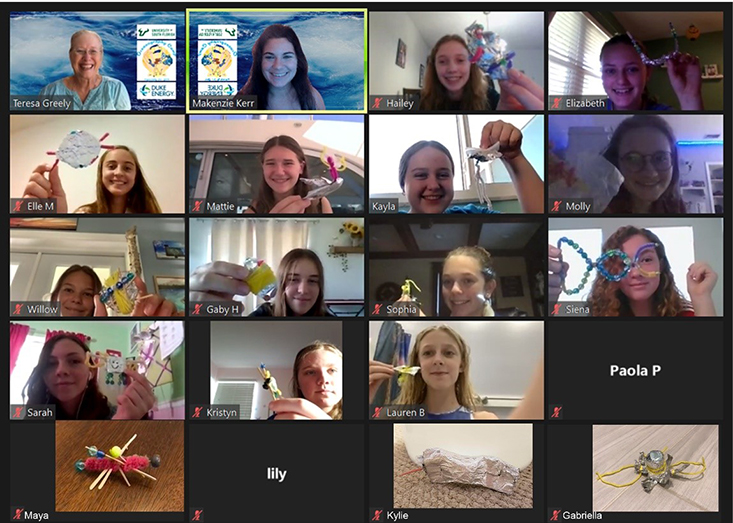Written by: Makenzie Kerr, Lab Manager & Outreach Coordinator for Dr. Mya Breitbart’s lab
Have you ever participated in a cardboard boat race or tried to make a boat out of foil hold as much weight as possible? Usually these competitions involve making things float, but what if your goal were to make something sink?
Build me up
Our Oceanography Camp for Girls (OCG) campers participated in a virtual competition on November 14th. The goal was to design the slowest sinking plankton model. Plankton are microscopic organisms that live in the surface waters of the ocean. Some plankton are plant-like (phytoplankton) and photosynthesize near the surface, while others are animal-like (zooplankton) and need to have access to their food near the surface. If the phytoplankton float, they receive too much light. If the zooplankton float, they can’t swim to find their prey. To find that happy medium of staying near the surface for as long as possible without floating, this year’s OCG participants used materials like foil, beads, and string to make their creative version of a plankton.
Everyone had a unique vision, forming a wide variety of shapes and sizes. Each camper had the chance to explain their design and inspiration, along with giving their plankton a name, like Rafiki, Bob, Black Thorn, and Sherman. OCG camper, Kayla made her plankton, a jellyfish named Jazz, with long pipe cleaner tentacles and a foil and wax paper bell. Everyone put a lot of thought into their designs.
Race time
Everyone “raced” their plankton three times in a 5-gallon bucket filled hallway with water to compute their average sink time. Many of the campers had to tweak their designs to make them sink, but that was part of the fun! The two winners of the competition (Lauren & Kylie) had over 20 seconds of sinking time, while the average time was around 7 seconds. Lauren said that she had tried this activity before and used past experiences to make her successful design.
After the race, our group came together to reflect on the learning and reinforce the importance of plankton to the ocean’s health. When asked to describe their day in three words, the girls said: fun, creative, interesting, exciting, and innovative. Check out more OCG ‘virtual’ fun by following us on social media.
Next up
Our plan is to continue our virtual monthly meetings through February 2021. We hope to complete the program in March 2021 with a one-week, outdoor, field-based, immersion camp. Future monthly meeting themes include December – Coastal Cleanup, January – Fisheries Management, and February – Ocean inspired Art with Watercolor Painting.
Follow us:
Facebook: www.facebook.com/OceanographyCampForGirls
Instagram: @ocgoutreach (https://www.instagram.com/ocgoutreach)
Twitter: @OCG_Outreach (https://twitter.com/OCG_Outreach)
Additional resources:
